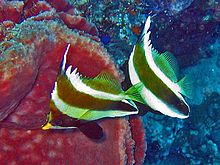Heniochus chrysostomus
| Heniochus chrysostomus | |
|---|---|
 |
|
| Heniochus chrysostomus from Borneo | |
| Scientific classification | |
| Kingdom: | Animalia |
| Phylum: | Chordata |
| Class: | Actinopterygii |
| Order: | Perciformes |
| Family: | Chaetodontidae |
| Genus: | Heniochus |
| Species: | H. chrysostomus |
| Binomial name | |
|
Heniochus chrysostomus G. Cuvier, 1831 |
|
| Synonyms | |
|
|
Heniochus chrysostomus, commonly called threeband pennantfish, threeband bannerfish or pennant bannerfish, is a fish of the family Chaetodontidae native to the central Indo-Pacific.
The threeband pennantfish is a small-sized fish that can reach a maximum length of 18 cm.
The body is laterally flattened, with a basic white color and three broad oblique brown bands. The first dark brown band runs from the forehead up to the ventral fins, the second from the dorsal fin to the anal fin, the third is adjacent to the dorsal fin. The first rays of the dorsal fin is elongated and looks like a black and white feather. This bannerfish has a distinctive yellow coloration pattern on the mouth, top of the snout and running between its eyes. The posterior part of its dorsal fin, its caudal fin and the pectoral fins are orange-yellow. Juveniles have an ocellus which is a black spot rimmed with orange-yellow, on the bottom of its anal fin.
The threeband pennantfish is widespread throughout the tropical and subtropical waters of the central Indo-Pacific from the western coast of India to Polynesia and from south Japan to New-Caledonia.
The threeband pennantfish typically inhabits coral-rich areas of reef flats, lagoon and seaward reefs at a depth of 2–40 metres (6 ft 7 in–131 ft 3 in). Juveniles are usually found in lagoons and estuaries.
The threeband bannerfish lives in pairs and feeds on coral polyps.
Out of some fishing activities to collect some specimen for aquarium, there do not appear to be any current threats to this species. However, it is listed as Least Concern (LC) by the IUCN.
...
Wikipedia

